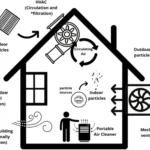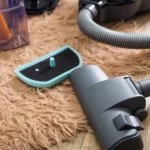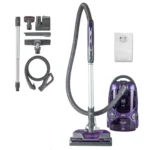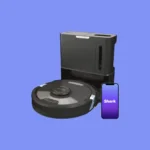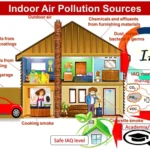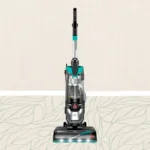Introduction: Why Choosing the Right Smart Vacuum Cleaner is Important for Allergies and Asthma
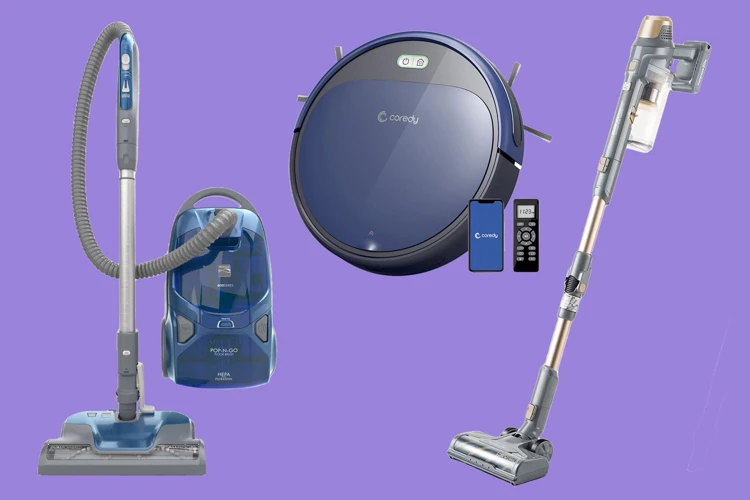
If you suffer from allergies or asthma, then choosing the right smart vacuum cleaner can make a significant difference in your health and well-being. The right vacuum cleaner can help remove the allergens and irritants that can trigger allergy and asthma symptoms, making your home a healthier place to live. On the other hand, using the wrong vacuum cleaner can actually worsen your symptoms by spreading more dust and allergens into the air.
Fortunately, there are several features that you can look for in a quiet smart vacuum cleaner that can help reduce allergy and asthma symptoms. These features include HEPA filters, low noise level, multi-stage filtration, smart navigation, app control and voice commands, and long battery life.
HEPA filters are one of the most important features to look for in a smart vacuum cleaner for allergies and asthma. These filters are designed to remove even the tiniest particles from your home, including dust mites, pet dander, and pollen. HEPA filters have been proven to be effective at removing up to 99.97% of particles from the air. To learn more about the benefits of using a quiet vacuum cleaner for allergies and asthma, check out /benefits-quiet-vacuum-allergies-asthma/.
Another important feature to look for in a smart vacuum cleaner is a low noise level. Noise can be particularly bothersome for people with allergies and asthma, and it can even trigger symptoms. A quiet vacuum cleaner can help reduce stress and improve sleep, along with reducing allergy and asthma symptoms. To learn more about the best quiet vacuum cleaners for allergies and asthma, check out /quiet-smart-vacuum-cleaners-allergies-asthma/.
Multi-stage filtration is also important in a smart vacuum cleaner for allergies and asthma. This type of filtration includes pre-filters, HEPA filters, and carbon filters, which work together to remove different types of particles and odors from your home. Smart navigation is also an important feature that can help the vacuum cleaner navigate your home and avoid obstacles. By avoiding obstacles, the vacuum cleaner can clean more effectively, which can result in cleaner air.
Finally, app control and voice commands can help make it easier to control your vacuum cleaner and keep your home clean. You can use these features to start, stop, schedule, and customize cleaning sessions. These features can help you keep your home clean and free from allergens and irritants, which can help reduce allergy and asthma symptoms. To learn more about how smart vacuum cleaners can reduce asthma and allergy symptoms, check out /smart-vacuum-cleaners-reduce-asthma-allergy-symptoms/.
Choosing the right smart vacuum cleaner can make a significant difference in your health and well-being if you suffer from allergies and asthma. By looking for features like HEPA filters, low noise levels, multi-stage filtration, smart navigation, app control and voice commands, and long battery life, you can find the perfect vacuum cleaner to meet your needs. To find the best quiet vacuum cleaners for allergies and asthma, check out /best-quiet-vacuum-for-allergies/.
Feature #1: HEPA Filters
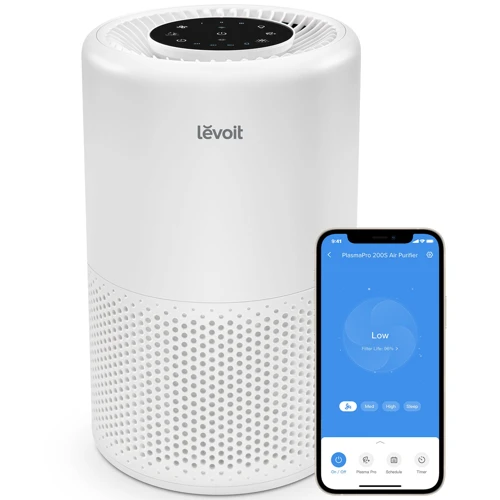
Are you constantly suffering from allergies and asthma attacks? One of the solutions to alleviate your symptoms is by choosing the right smart vacuum cleaner that offers features to help reduce airborne allergens in your home. One such feature is a HEPA filter. But what is a HEPA filter, why is it crucial for allergy and asthma sufferers, and how do you select a quiet smart vacuum cleaner with such a feature? Let’s find out.
What Are HEPA Filters?
HEPA filters, or High-Efficiency Particulate Air filters, are specialized air filters that are designed to capture over 99.97% of all conventional airborne particles. These particles include dust, dirt, pollen and other allergens, as well as pet dander, mold spores and even bacteria. HEPA filters can capture particles as small as 0.3 microns, which is 300 times smaller than the width of a human hair.
A major benefit of HEPA filters is that they can help alleviate allergies and asthma symptoms by trapping these tiny particles that cause respiratory issues. The American Lung Association recommends HEPA filters as a way to improve indoor air quality.
HEPA filters are made of several layers of very fine mesh, which enables them to capture particles that are too small for ordinary filters. They work by forcing air through these layers, trapping impurities in the process. Because of their high level of filtering, HEPA filters are often used in medical settings, such as hospitals and laboratories, as well as in commercial settings, like clean rooms.
In terms of vacuum cleaners, HEPA filters are a must-have feature for allergy and asthma sufferers, as they can significantly reduce the amount of airborne particles in the air. When choosing a smart vacuum cleaner with HEPA filters, it’s important to check if the filters are replaceable and washable, as this can impact the vacuum’s performance over time. A good HEPA filter should be able to eliminate particles without releasing any back into the air.
Table: HEPA Filters
| Advantages | Disadvantages |
|:—:|:—:|
| Traps over 99.97% of airborne particles | Can be expensive |
| Can help alleviate allergies and asthma symptoms | May require frequent replacements |
| Used in medical and commercial settings | Can affect vacuum’s suction power |
| Can improve indoor air quality | May not eliminate odors |
Why Are HEPA Filters Important for Allergy and Asthma Sufferers?
Allergies and asthma can significantly affect the quality of life of those who suffer from them. One way to alleviate these health conditions is to reduce the amount of allergens present in the environment, especially in the air that we breathe. This is where HEPA filters come in as an important feature to consider when choosing a smart vacuum cleaner.
What is HEPA filtration and how does it work?
HEPA stands for High-Efficiency Particulate Air. HEPA filters work by trapping tiny particles that other filters would typically recirculate back into the air we breathe. HEPA filters are designed to capture 99.97% of airborne particles as small as 0.3 microns in size. To give a point of reference, the diameter of a human hair is about 70 microns in size. This means that HEPA filters can capture a wide range of particles including pet dander, dust mites, pollen, and even some viruses.
| Particles HEPA Filters can capture | Percentage | Size in microns |
|---|---|---|
| Pollen | 99.97% | 10-100 |
| Dust mites | 99.97% | 0.5-50 |
| Bacteria | 99.97% | 0.3-60 |
| Virus | 99.97% | 0.005-0.3 |
How do HEPA Filters benefit allergy and asthma sufferers?
HEPA filters reduce the amount of allergens and irritants in the air that cause allergies and asthma. The filters capture airborne particles, rather than allowing them to recirculate through the air, so allergens are removed from the environment. This is especially important for those with allergies or asthma, as it helps to reduce symptoms such as sneezing, runny nose, coughing, and wheezing.
How to Choose a Smart Vacuum Cleaner with HEPA Filters?
When choosing a smart vacuum cleaner with HEPA filters, you need to ensure that the filters are true HEPA filters. The vacuum cleaner must have a sealed system that ensures that all the air passes through the HEPA filter instead of releasing it back into the air. Check the product specifications to ensure that the vacuum cleaner has a true HEPA filter and a sealed system.
How to Choose a Smart Vacuum Cleaner with HEPA Filters?
When choosing a smart vacuum cleaner with HEPA filters, there are a few factors that you should take into consideration. Here are some tips to help you find the perfect one:
- Check for HEPA certification: Before purchasing a vacuum cleaner, make sure that it has a genuine HEPA filter. Look for vacuums that meet the HEPA standard, which captures 99.97% of particles as small as 0.3 microns. This will ensure that the vacuum will effectively remove allergens and asthma triggers from your home.
- Type of vacuum: There are many types of vacuum cleaners with HEPA filters available, including upright, canister, and stick vacuums. Consider your cleaning preferences and needs to determine which type of vacuum will work best for you. For example, an upright vacuum may be more suitable for cleaning carpets, while a canister vacuum may be better for hard floors and stairs.
- Suction power: Look for a vacuum cleaner with strong suction power that can effectively suck up dust and dirt. This is especially important if you have carpeted floors or pets that shed.
- Capacity and maintenance: Consider the size of the dustbin or bag and how frequently it needs to be emptied or replaced. Also, check the maintenance requirements of the vacuum cleaner, such as how often the filter needs to be replaced.
- Additional features: Look for smart vacuum cleaners with additional features that will make cleaning easier and more efficient, such as automatic floor mapping or voice command control.
By taking these factors into account, you can choose a smart vacuum cleaner with HEPA filters that will effectively remove allergens and asthma triggers from your home and improve your indoor air quality.
Feature #2: Low Noise Level
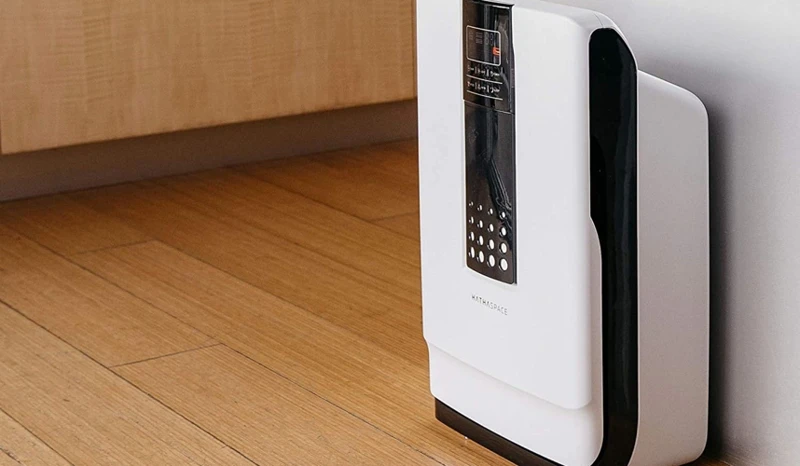
For allergy and asthma sufferers, a quiet vacuum cleaner can make all the difference. The sound of a traditional vacuum cleaner can cause distress to those with sensitive respiratory systems. That’s why it’s crucial to choose a vacuum cleaner with a low noise level. Such a feature provides comfort for allergy and asthma sufferers during cleaning sessions. How can you determine the ideal vacuum cleaner noise level for allergy sufferers? Keep reading to learn more.
Why Is Low Noise Level Important for Allergy and Asthma Sufferers?
A low noise level is crucial for allergy and asthma sufferers because these conditions are often associated with hypersensitivity to environmental stimuli, including loud sounds. Vacuum cleaners can be particularly disruptive and intrusive, especially if they produce loud and jarring noises. Excessive noise can also cause stress and agitation, which can exacerbate allergies and asthma symptoms.
To understand why a quiet smart vacuum cleaner is important for allergy and asthma sufferers, let’s take a closer look at the impact of noise on these conditions:
| Noise Level | Effect on Allergies and Asthma |
|---|---|
| Above 85 decibels | Can cause hearing damage, stress, and irritability, which can worsen allergies and asthma symptoms |
| Between 60 and 85 decibels | May cause annoyance, distraction, and discomfort, which can trigger allergies and asthma symptoms |
| Below 60 decibels | Considered quiet and peaceful, which can promote relaxation and reduce stress that can contribute to allergies and asthma symptoms |
As you can see from the table above, a vacuum cleaner that produces loud and disruptive noises can have a negative impact on allergy and asthma sufferers. As a result, it is crucial to choose a quiet smart vacuum cleaner that emits low levels of noise to prevent stress and agitation. Having a low noise level can also ensure that the user can comfortably use the vacuum cleaner without disturbing other people in the same room or area.
A quiet smart vacuum cleaner is ideal for allergy and asthma sufferers who may require frequent cleaning to maintain a dust-free and allergen-free environment. With a quiet smart vacuum cleaner, they can perform their cleaning tasks without worrying about causing excessive noise and discomfort.
Choosing a quiet smart vacuum cleaner with low noise levels is essential for allergy and asthma sufferers to prevent aggravation of symptoms and maintain a clean and peaceful living environment.
How to Choose a Quiet Smart Vacuum Cleaner?
When choosing a quiet smart vacuum cleaner, there are several important factors to consider to ensure that it meets your needs for allergies and asthma. Here is a table highlighting the features to look for:
| Feature | Description |
|---|---|
| Noise level | Look for a vacuum cleaner with a noise level of 60 decibels (dB) or lower. This will help prevent any disturbances while you clean. |
| Power settings | A quiet vacuum cleaner may have less powerful suction. Look for one with adjustable power settings so you can clean effectively while still minimizing noise. |
| Motor type | Choose a vacuum cleaner with a brushless motor as it will produce less noise and vibration than a traditional motor. |
| Corded or cordless | Cordless vacuum cleaners can be more convenient but they may have a shorter battery life. If you have a large home or need to clean for an extended period of time, consider a corded option to ensure consistent power and suction. |
| Brand | Choose a reputable brand that has been known to produce high-quality and durable vacuum cleaners with low noise levels. |
Considering these factors, you can select a vacuum cleaner that will be effective and convenient for cleaning while also being quiet enough to avoid any discomfort or disturbance to allergy and asthma sufferers in your home.
What Is the Ideal Noise Level for a Smart Vacuum Cleaner?
When it comes to choosing a quiet smart vacuum cleaner for allergies and asthma, the ideal noise level is an important factor to consider to ensure a comfortable and healthy living environment. Here are a few things to keep in mind when looking for the perfect noise level in a smart vacuum cleaner:
- The ideal noise level for a smart vacuum cleaner is less than 70 decibels: Research suggests that prolonged exposure to noise levels above 70 decibels can cause damage to the ears and worsen allergies and asthma symptoms. It is vital to look for a vacuum cleaner that has a noise level lesser than 70 decibels.
- Look for a vacuum cleaner with variable suction speeds: In general, the lower the suction speed of the vacuum cleaner, the quieter it will be. A smart vacuum cleaner that offers variable suction speeds will help you adjust the noise level to your specific needs and preferences.
- Consider a vacuum cleaner with noise-reducing features: Some smart vacuum cleaners come with noise-reducing features such as sound insulation and brushless motors that help to reduce the overall noise level. Such features can ensure that your smart vacuum cleaner works quietly and efficiently, without disturbing your household or worsening your allergies and asthma symptoms.
It is important to keep in mind that while noise level is an essential factor, it should not be the only one considered when choosing a smart vacuum cleaner for allergies and asthma. Ensure that you choose a vacuum cleaner that also has HEPA filters, multi-stage filtration, smart navigation, app control, voice commands, and a long battery life to ensure effective cleaning, comfort, and a healthy living environment.
Feature #3: Multi-stage Filtration
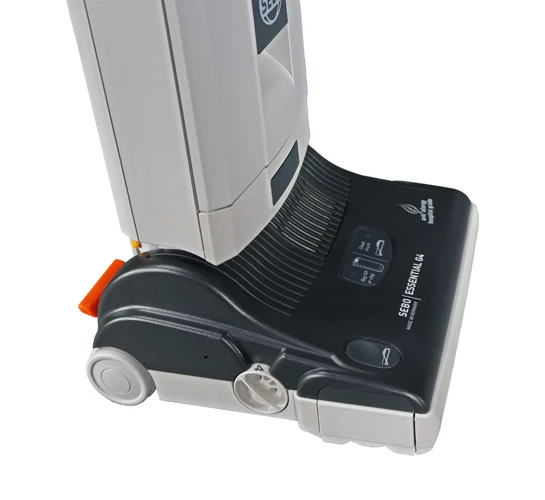
Ensuring that your household stays clean and free of allergens is a top priority for many allergy and asthma sufferers. However, traditional vacuum cleaners may not provide the kind of filtration that can give you the peace of mind you need. This is where the multi-stage filtration feature of a smart vacuum cleaner comes into play. It provides a superior cleaning experience by removing even the smallest particles from the air, leaving your home cleaner and healthier. Let’s dive into what multi-stage filtration is and why it’s so important for those who suffer from allergies and asthma.
What Is Multi-Stage Filtration?
Multi-stage filtration is a process that involves multiple steps designed to remove impurities from the air. In a smart vacuum cleaner, multi-stage filtration typically includes a pre-filter, HEPA filter, and sometimes an activated carbon filter.
The pre-filter is the first stage of the multi-stage filtration process. It captures larger debris like pet hair, dust bunnies, and even crumbs. This filter is usually washable and designed to be reused multiple times.
A HEPA filter is the core component of multi-stage filtration. It’s the second stage of the process, and it’s designed to capture microscopic particles like dust mites, pollen, and other allergens. HEPA filters capture 99.97% of particles that are as small as 0.3 microns.
An activated carbon filter is an optional extra step in the multi-stage filtration process. Activated carbon is a special type of charcoal that has been treated with oxygen to make it more porous. It’s great at absorbing and trapping odors, smoke, and chemicals, making it a valuable asset to those who have allergies or asthma.
By using a multi-stage filtration system, the smart vacuum cleaner can effectively remove allergens and other harmful particles from the air. This is essential for those who suffer from allergies or asthma, as removing these particles can help reduce symptoms and improve their overall quality of life.
Why Is Multi-Stage Filtration Important for Allergy and Asthma Sufferers?
When it comes to choosing a smart vacuum cleaner for allergies and asthma sufferers, multi-stage filtration is a crucial feature that cannot be overlooked. Multi-stage filtration refers to a process where air is passed through multiple filters, each designed to capture different sizes of particles. This ensures that the air that is released back into the room is as clean and allergen-free as possible.
But why is multi-stage filtration important for allergy and asthma sufferers? Allergies and asthma are caused by a variety of airborne triggers such as dust mites, pet hair and dander, pollen, and mold spores, among others. These triggers are usually too small to be seen by the naked eye and can easily infiltrate the air in our homes.
A vacuum cleaner with multi-stage filtration can effectively capture these airborne triggers as it sucks in air and passes through several layers of filtration. The first filter usually captures larger particles such as pet hair and dander, while subsequent filters trap smaller and finer particles like pollen and dust mites. This ensures that the air released back into the room is much cleaner than before and free from allergens that can trigger allergy and asthma symptoms.
Multi-stage filtration technology is incredibly effective at capturing even the tiniest of particles. HEPA filters, for instance, are capable of capturing up to 99.97% of particles as small as 0.3 microns. This level of filtration is unmatched by any other technology or filtration system.
The importance of multi-stage filtration cannot be overstated. It is a crucial feature for allergy and asthma sufferers as it ensures that air released back into the room is as clean and allergen-free as possible. Make sure to choose a smart vacuum cleaner that features advanced multi-stage filtration technology, including HEPA filters, to effectively manage your allergies and asthma symptoms.
| Features of Multi-Stage Filtration | Benefits to Allergy and Asthma Sufferers |
|---|---|
| Captures larger particles such as pet hair and dander in the first filter | Reduces the number of allergens circulating in the air, thereby reducing the likelihood of allergic reactions or asthma attacks |
| Traps smaller and finer particles like pollen and dust mites in subsequent filters | Significantly improves indoor air quality |
| HEPA filters capture up to 99.97% of particles as small as 0.3 microns | Offers unmatched filtration performance and traps even the tiniest of airborne allergens and irritants |
How to Choose a Smart Vacuum Cleaner with Multi-Stage Filtration?
When it comes to choosing a smart vacuum cleaner with multi-stage filtration, there are several factors that you should consider. Multi-stage filtration is important for allergy and asthma sufferers because it helps to remove a wide range of particles from the air, including dust, pet dander, and pollen. To choose a vacuum cleaner with effective multi-stage filtration, consider the following factors:
| Factor | Description |
|---|---|
| Filtration stages | Look for a vacuum cleaner with multiple filtration stages, such as a pre-filter, HEPA filter, and activated carbon filter. Each stage helps to remove different types of particles from the air. |
| Filter efficiency | Check the efficiency rating of the filters used in the vacuum cleaner. HEPA filters are the most effective at removing small particles, with a rating of at least 99.97% efficiency. |
| Clean filter indicator | Choose a vacuum cleaner with a clean filter indicator light, which notifies you when it’s time to change the filter. This ensures that the vacuum cleaner is always running at peak efficiency. |
| Dustbin capacity | Consider the dustbin capacity of the vacuum cleaner. A larger dustbin means that you’ll need to empty it less frequently, which is especially important if you have allergies or asthma. |
| Filter replacement cost | Take into account the cost of replacing the filters in the vacuum cleaner. Some brands have more affordable replacement filters than others, which can impact the overall cost of ownership over time. |
By considering these factors when choosing a smart vacuum cleaner, you can ensure that you select one with effective multi-stage filtration that will help to improve the air quality in your home and reduce allergy and asthma symptoms.
Feature #4: Smart Navigation
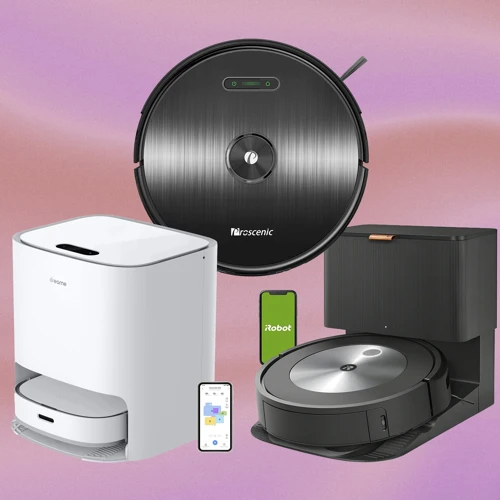
Are you tired of struggling with a vacuum cleaner that seemingly has a mind of its own? One that bumps into furniture, gets stuck in corners, and misses spots? For allergy and asthma sufferers, this can be a nightmare, as the dust and allergens that are left behind can trigger symptoms. That’s why smart navigation is a game-changer when it comes to vacuum cleaners. With sensors, cameras, and mapping technology, a smart vacuum cleaner can intelligently navigate your home, covering every inch and leaving behind a clean, allergen-free environment. But what exactly is smart navigation and how can you find a vacuum cleaner with this feature? Let’s dive in.
What Is Smart Navigation in a Vacuum Cleaner?
Smart Navigation is a high-tech feature that sets advanced vacuum cleaners apart from traditional ones. By using smart sensors and mapping technologies, smart vacuum cleaners can navigate a room autonomously, avoiding obstacles and creating an efficient cleaning pattern.
Some benefits of smart navigation include:
- Increased efficiency: Smart navigation allows the vacuum cleaner to move in a systematic pattern, covering the entire floor without missing spots.
- Time-saving: Instead of aimlessly wandering around the room, a vacuum cleaner with smart navigation can finish cleaning more quickly and efficiently, saving time and energy.
- Less wear and tear: Since the vacuum cleaner is directed by sensors and technology, there is a lower risk of bumping into furniture or walls, causing damage over time.
There are a few different types of technology that enable smart navigation for vacuum cleaners, including:
- Laser-guided navigation: This technology uses lasers to measure the distance between the vacuum cleaner and nearby objects, creating a map of the room to follow.
- Camera-based navigation: In this approach, a camera mounted on the vacuum cleaner captures images of the room and uses that data to orient itself as it moves through the space.
- Infrared-based navigation: This uses infrared sensors to detect obstacles and create a path around them.
Smart navigation is an essential feature for allergy and asthma sufferers, as it simplifies the cleaning process and minimizes the amount of time the vacuum cleaner spends in contact with dust and allergens.
Why Is Smart Navigation Important for Allergy and Asthma Sufferers?
Smart navigation is an important feature to consider when choosing a vacuum cleaner for allergy and asthma sufferers. Here are some reasons why:
1. Efficiency: Smart navigation allows the vacuum cleaner to move around obstacles and clean efficiently without missing any spots. This means less time spent vacuuming, which can be especially important for people with allergies and asthma.
2. Reduced Disruption: Smart navigation reduces the need for manual control of the vacuum cleaner, which also means less disruption for allergy and asthma sufferers. This is because manual control can cause dust and allergens to become airborne, which can trigger allergies and asthma.
3. Better Cleaning Quality: Smart navigation allows the vacuum cleaner to map your home and clean every area thoroughly. This means that even hard-to-reach areas with allergens, such as under furniture or in corners, can be cleaned effectively.
4. Improved Air Quality: Smart navigation reduces the need for multiple passes over the same area, which can reduce the amount of dust and allergens in the air. This means better air quality for allergy and asthma sufferers.
Smart navigation is an important feature for any vacuum cleaner used by people with allergies and asthma. It can improve cleaning efficiency, reduce disruption, improve cleaning quality, and improve air quality.
How to Choose a Smart Vacuum Cleaner with Smart Navigation?
When choosing a smart vacuum cleaner with smart navigation, there are several important factors to consider. Here are some of the most crucial features to look for:
| Feature | Description |
|---|---|
| Mapping Technology | The smart vacuum cleaner should have advanced mapping technology that allows it to create a map of your home and navigate around obstacles with ease. Look for models that use laser or optical mapping. |
| Obstacle Detection | You should also look for a smart vacuum cleaner with obstacle detection, which allows it to sense objects in its path and avoid colliding with them. This is particularly important if you have furniture or other objects in your home that could be damaged if the vacuum runs into them. |
| Boundary Markers | Some smart vacuums come with boundary markers, which allow you to set virtual boundaries for the vacuum to clean within. This can be particularly useful if there are areas of your home that you don’t want the vacuum to go, such as a room with delicate décor or a child’s play area. |
| Multi-Room Navigation | If you have a large home or multiple floors, look for a smart vacuum cleaner with multi-room navigation capabilities. This allows the vacuum to move between rooms or floors without getting lost or confused. |
By choosing a smart vacuum cleaner with these features, you can ensure that it will be able to navigate your home with ease and clean effectively without damaging your furniture or décor.
Feature #5: App Control and Voice Commands
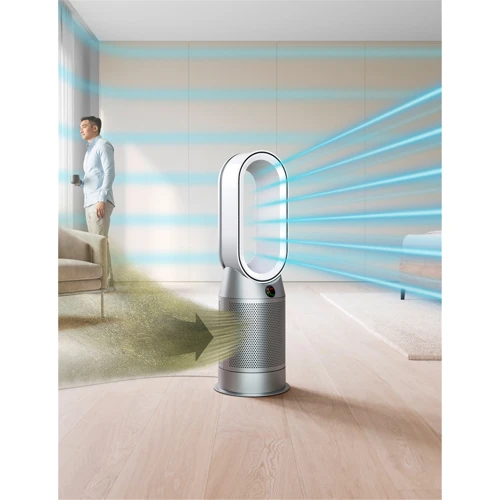
Do you ever wish you had a personal assistant to clean your home while you relax? With advanced technology, this is now possible with smart vacuum cleaners equipped with app control and voice commands. These features add convenience and ease to the cleaning routine and are especially important for allergy and asthma sufferers who want to minimize physical exertion during cleaning. In this section, we will explore the benefits of app control and voice commands in a smart vacuum cleaner and guide you on how to choose the right one.
What Is App Control and Voice Commands in a Smart Vacuum Cleaner?
App control and voice commands are two powerful features that are becoming increasingly popular in the world of smart home appliances, including smart vacuum cleaners. These features allow you to control your vacuum cleaner remotely using your smartphone or with voice commands via a smart speaker.
App control: With app control, you can easily set up and schedule cleaning tasks, control the vacuum’s movement, turn it on or off, and manage its settings from your smartphone. This feature enables you to control your vacuum cleaner effortlessly and provides you with flexibility and convenience as you can manage your cleaning tasks from anywhere you are.
Voice commands: Voice commands allow you to control your vacuum cleaner hands-free. This feature is particularly helpful for people with allergies and asthma, as it enables them to control their vacuum cleaner without physically interacting with it, reducing the possibility of inhaling dust and allergens. By using voice commands, you can start and stop the vacuum, change cleaning modes, and get information about the vacuum’s status, all without lifting a finger.
Having app control and voice commands in your smart vacuum cleaner can make your life a lot easier, especially if you have allergies or asthma. With these features, you can ensure that your home is always clean without putting yourself at risk of inhaling harmful allergens and dust.
When choosing a smart vacuum cleaner, consider options that offer app control and voice commands. Look for models that are compatible with your smartphone operating system and smart speaker, and make sure that the app is easy to use and the voice commands are accurate and respond well. These features will not only help you keep your home clean but also provide you with a more convenient, hands-free cleaning experience.
Why Is App Control and Voice Commands Important for Allergy and Asthma Sufferers?
For allergy and asthma sufferers, managing indoor air quality is crucial. Using a smart vacuum cleaner with app control and voice commands means you can control your vacuum cleaner without having to physically touch it or be in the same room. This can help reduce exposure to airborne allergens and pollutants that can trigger symptoms.
Here are some reasons why App Control and Voice Commands are important for allergy and asthma sufferers:
- Convenience: With app control and voice commands, you can easily start and stop your smart vacuum cleaner from any room in the house without having to physically press buttons on the device.
- Controlling allergens: For allergy and asthma sufferers, it’s important to reduce exposure to airborne allergens and pollutants that can trigger symptoms. App control and voice commands allow you to schedule cleaning sessions and ensure your floors are free of dust, pet hair, and other irritants.
- Smart automation: With app control, you can program your smart vacuum cleaner to automatically turn on and start cleaning at specific times, so you don’t have to worry about manually ensuring a clean living space.
- Increase independence: For individuals with limited mobility or disabilities, app control and voice command features can provide a sense of independence and reduce the need for physical labor.
App control and voice commands are a convenient and helpful feature for individuals with allergies and asthma who want to maintain clean and healthy indoor air quality without having to physically manipulate their vacuum cleaner.
How to Choose a Smart Vacuum Cleaner with App Control and Voice Commands?
Choosing a Smart Vacuum Cleaner with App Control and Voice Commands can be a game-changer for those suffering from allergies and asthma. Having complete control of your smart vacuum cleaner from your phone or with voice commands can save energy and reduce exposure to allergens. Here are some tips to help you choose a smart vacuum cleaner with app control and voice commands:
| Tip | Description |
|---|---|
| Compatibility | Make sure the app is compatible with your phone’s operating system, such as Android or iOS. |
| App Features | Check what features the app offers, such as scheduling, customizing cleaning settings, and receiving alerts. |
| Voice Control | Consider if the smart vacuum cleaner supports voice commands and if it is compatible with your home assistant, such as Amazon Alexa or Google Assistant. |
| Connectivity | Make sure the smart vacuum cleaner is compatible with Wi-Fi and Bluetooth so you can connect it to your phone and smart home devices. |
| User Interface | Check if the app has an easy-to-use interface and provides clear information about the smart vacuum cleaner’s status and cleaning progress. |
By taking these tips into consideration, you can choose a smart vacuum cleaner with app control and voice commands that makes cleaning your home easier and safer for allergy and asthma sufferers. With the flexibility and convenience of app control and voice commands, you can maintain a healthy and clean home environment without any hassle.
Feature #6: Battery Life
As technology advances, the convenience of having a smart vacuum cleaner has become more widespread. However, for those who suffer from allergies and asthma, having a vacuum cleaner that can clean their indoor space efficiently without compromising their health is crucial. One of the essential features to consider is the battery life. Having a vacuum cleaner with a long battery life ensures that it can clean the desired area without requiring frequent recharging, making it convenient for those who suffer from allergies and asthma. In this section, we will dive into the importance of battery life and how to choose a smart vacuum cleaner that suits your specific needs.
Why Is Battery Life Important for Allergy and Asthma Sufferers?
Battery Life is crucial for Allergy and Asthma Sufferers when choosing a Smart Vacuum Cleaner. It determines how long the vacuum cleaner can run before needing to be recharged, and it is important to consider this when looking for a vacuum cleaner that will work for your needs.
| Reasons Why Battery Life is Important for Allergy and Asthma Sufferers |
|---|
| 1. Efficient Cleaning: Allergy and Asthma Sufferers require frequent cleaning of their surroundings to prevent the accumulation of dust and allergens. A vacuum cleaner with a long battery life ensures that it can be used for extended periods without interruptions, thereby allowing for efficient and thorough cleaning. |
| 2. Convenience: A vacuum cleaner with a long battery life is very convenient to use, as it allows you to clean without having to constantly search for an electrical outlet or change batteries frequently. |
| 3. Time-saving: Time is of the essence when it comes to Allergy and Asthma Sufferers’ health. Cleaning the home can be time-consuming, but a vacuum cleaner with a long battery life will help cuts down cleaning time and provide you with more time to focus on other important issues. |
| 4. Versatility: A vacuum cleaner with a long battery life is often portable and can be used anywhere in the house. This feature is advantageous as it enables the cleaning of tight spaces, where standard vacuum cleaners cannot fit in with a cord. |
As a result, it is critical to choose a quiet smart vacuum cleaner equipped with a long battery life to ensure it can function at maximum efficiency for prolonged periods. The length of your vacuum cleaner’s battery life will be determined by how often you use it, and its maintenance level. Prioritize a vacuum cleaner with the highest battery life that fits your budget, and always check its recharge time in case you need to utilise it urgently.
How to Choose a Smart Vacuum Cleaner with Long Battery Life?
When choosing a smart vacuum cleaner with long battery life, there are several factors to consider to ensure that your investment will be worth it.
Battery Capacity: Check the battery capacity of the vacuum cleaner. In general, the higher the capacity, the longer the battery life. Look for a battery that has a capacity of at least 2000mAh.
Battery Type: Look for a vacuum cleaner with a lithium-ion battery. These types of batteries have longer life spans, excellent power output, and are preferable to other types of batteries.
Charging Time: Make sure that the vacuum cleaner has a quick charging time. Ideally, it should take no more than 4 hours to charge fully. This ensures that your vacuum cleaner is ready to use when you need it.
Runtime: Check how long the battery lasts between charges. A good runtime for a smart vacuum cleaner for allergies and asthma is at least 90 minutes. However, the longer the runtime, the better.
Smart Features: Look for smart features that help to preserve battery life. For example, some models have a feature to automatically shut off the vacuum cleaner when it’s not in use, or when the battery is fully charged.
Brand Reputation: Consider the reputation of the brand before purchasing. Brands with a good reputation for producing quality and durable vacuum cleaners are more likely to deliver on their promises, including long battery life.
By taking these factors into account and conducting research, you can make an informed decision when choosing a smart vacuum cleaner with long battery life that meets your needs for allergies and asthma.
| Factors to Consider | Criteria |
|---|---|
| Battery Capacity | Look for a battery capacity of at least 2000mAh |
| Battery Type | Choose a vacuum cleaner with a lithium-ion battery |
| Charging Time | Ensure it takes no more than 4 hours to fully charge |
| Runtime | At least 90 minutes is preferable |
| Smart Features | Choose a model with automated shut-off to preserve battery life |
| Brand Reputation | Consider brands with a good reputation for quality and durability |
Conclusion: Finding the Perfect Smart Vacuum Cleaner for Allergies and Asthma
Finding the perfect smart vacuum cleaner for allergies and asthma can make a significant difference in your overall health and wellbeing. A vacuum cleaner with HEPA filters, low noise level, multi-stage filtration, smart navigation, app control and voice commands, and long battery life can help reduce allergens and irritants in your indoor air and make cleaning more efficient and convenient.
When choosing a smart vacuum cleaner with these features, it’s essential to consider your specific needs and preferences. For instance, if you have severe allergies or asthma, a vacuum cleaner with a high-quality HEPA filter is crucial. If you live in a shared space or have pets, a quiet vacuum cleaner with multi-stage filtration and smart navigation may be ideal to avoid disturbing others.
It’s also essential to consider the budget and brand reputation of the smart vacuum cleaner. Opting for a reputable brand with positive customer reviews can help ensure that you’re investing in a high-quality and reliable product. Determining your budget beforehand can help you narrow down your options and choose a vacuum cleaner that meets your needs and falls within your price range.
Choosing the right smart vacuum cleaner with the essential features can make cleaning more effective, reduce allergens and irritants in your indoor air, and improve your overall quality of life, especially if you suffer from allergies and asthma. By considering the features discussed in this article and conducting thorough research, you can find the perfect smart vacuum cleaner that best suits your needs and helps you breathe easier.
Frequently Asked Questions
Can a vacuum cleaner worsen allergies and asthma symptoms?
Yes, if the vacuum cleaner does not have proper filtration or agitates dust and allergens, it can worsen allergies and asthma symptoms.
What is the importance of HEPA filters in a vacuum cleaner?
HEPA filters in a vacuum cleaner trap small particles that can trigger allergies and asthma, ensuring cleaner air in your home.
How often should I replace the HEPA filter in my vacuum cleaner?
It’s recommended to replace the HEPA filter in your vacuum cleaner every six months to maintain its effectiveness.
What is the ideal noise level for a smart vacuum cleaner?
The ideal noise level for a smart vacuum cleaner is around 60 decibels or lower, as it minimizes the disruption to allergy and asthma sufferers.
What is multi-stage filtration?
Multi-stage filtration refers to the filtration system within a vacuum cleaner that combines various filters to capture dust, dirt, and allergens.
Why is smart navigation important for allergy and asthma sufferers?
Smart navigation technology ensures that a vacuum cleaner moves efficiently and does not scatter allergens and dust, minimizing allergen exposure and triggering asthma symptoms.
What is app control and voice commands in a smart vacuum cleaner?
App control and voice commands allow the owner to operate the vacuum cleaner from their smartphone or with voice commands, making it more convenient for allergy and asthma sufferers with mobility issues.
Why is battery life important for allergy and asthma sufferers?
Long battery life ensures that the vacuum cleaner can run for an extended period, reducing the risk of allergens and dust particles accumulating in the air, which can trigger allergy and asthma symptoms.
How can I tell if a vacuum cleaner has a multi-stage filtration system?
You can check the vacuum cleaner’s specifications or read reviews to confirm if it has a multi-stage filtration system.
What should I consider when choosing a smart vacuum cleaner for allergies and asthma?
You should consider features such as HEPA filters, low noise level, multi-stage filtration, smart navigation, app control and voice commands, and battery life when choosing a smart vacuum cleaner for allergies and asthma.

